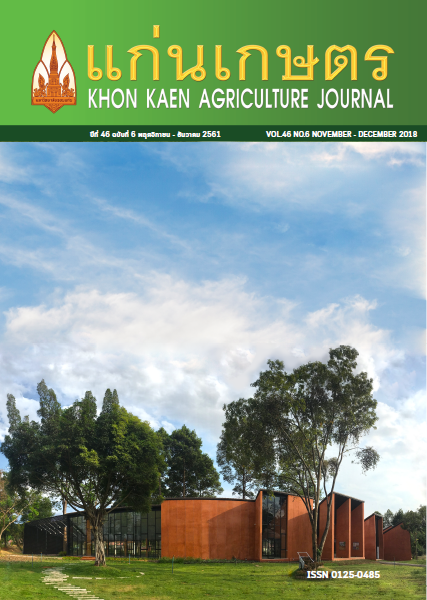Estimating variability of growing season and drought occurrence for rainfed lowland rice area by simulation model
Main Article Content
Abstract
A simulation model was used for estimating the start and end of growing period using rainfall data from 8 meteorological stations in the Northeast during 1951-2014. Three groups of rainfall based on mean across 64 years were separated to be high (1556 mm.), intermediate (1397 mm.) and low (1161 mm.) rainfall groups. To determine the difference in rainfall, start and end of growing periods (SGP and EGP) and opportunity of drought occurrence, the rainfall data were grouped into 5 periods, 1951-1979, 1980-1989, 1990-1999, 2000-2009 and 2010-2014 in comparison to means of 64 years. Amount of rainfall among the periods was not different, excepted 2000-2009 which was slightly increased. Start and end of growing period were determined at 80 percentage probability. Mean of SGP was not different between the high and intermediate rainfall groups (late May) but it was late under low rainfall group to mid-June to late July. Among the periods of years, there was no difference but it trended to be earlier for the last 5 years period. Mean of EGP across 64 years was earlier for the lower than higher rainfall groups. Among the periods, there was no difference, excepted during 2010-2014 which trended to be slightly delayed. Possibility of early season drought (ESD) was higher in low than high and intermediate rainfall groups. However, there was the increase during the last period in comparison to mean of 64 years for intermediate rainfall group. Late season drought (LSD) occurrence was the same as ESD which higher in lower than higher rainfall groups. The result suggested that there was not much change in SGP and EGP. However, there was increase in possibility of ESD under low and intermediate rainfall groups. In order to minimize risk to the change, planting date and rice varieties need to be considered.
Article Details
References
ARDA. 2016. Annual report in 2016 of project Strengthening Farmers’ Adaptation to Climate Change in Rainfed. Agricultural Research Development Agency, ARDA, (Public Organization). 101 pp.
Fukai, S., Rajatasereekul, S., Boonjung, H., and E. Skulkhu. 1995. Simulation modeling to quantify the effect of drought for rainfaed lowland rice in Northeast Thailand. In: Proceedings of International Rice Research Conference on Fragile Lives in Fragile Ecosystem. February 13-17, 1995, Los Banos, Laguna, Philippines.
Fukai, S. 1999. Phenology in rainfed lowland rice. Field Crops Research. 64: 51-60.
Inthavong, T. 2009. Spatial variation in water availability, soil nutrient and water constraints for rainfed lowland rice production in Savannakhet province, Southern Lao PDR. Ph.D. Thesis in Land, Crop and Food Sciences, University of Queensland, Brisbane, Australia.
Inthavong, T., Tsubo, M., and S. Fukai. 2011. A water balance model for characterization of length of growing period and water stress development for rainfed lowland rice. Field Crops Research.121: 291–301.
Ouk, M., Fukai, S., Cooper, M., and H.J. Nesbitt. 2001. Influence of seedling time and seedling age at time of transplanting on the productivity of rainfed lowland rice with different levels of photoperiod sensitivity. In: Increased lowland rice production in the Mekong region. ACIAR proceeding No. 101 (Fukai, S. and Basnayake, J., ed.) pp. 259-270. The Australian Centre for International Agricultural Research, Canberra, Vientiane, Lao PDR.
Phakamas, N.,Jintrawet, A., Patanothai, A., Sringam, P and G. Hoogenboom. 2013. Estimation of solar radiation based on air temperature and application with the DSSAT v4.5 peanut and rice simulation models in Thailand. Agricultural and Forest Meteorology. 180: 182-193.
Rice Department. 2016. Situation of rice production in main growing season 2016/2017. load: Systematic review of the published literature. http://www.ricethailand.go.th/web/home/images/brps/text2559/15092559/15092559.pdf. Accessed 25 Oct. 2017
Saxton, K. E., and Rawls, W. J. 2006. Soil Water Characteristic Estimates by Texture and Organic Matter for Hydrologic Solutions. Soil Science Society of America Journal. 70: 1569–1578.
Sujariya, S. 2017. Effects of climate change on growing period and yield performance under rainfed lowlandice in Northeast, Thailand. Ph.D. Thesis in Agronomy, faculty of Agriculture, Khon Kean University.
Tsubo, M., Fukai, S., Basnayake, J., Tuong, T. P., Bouman, B., and Harnpichitvitaya, D. 2007. Effects of soil clay content on water balance and productivity in rainfed lowland rice ecosystem in Northeast Thailand. Plant Production Science. 10: 232-241.
van Keulen, H. and Wolf, J. (Eds.) 1986. Modelling of Agricultural Production: Weather, Soils and Crops. Simulation Monographs. PUDOC, Wageningen.


